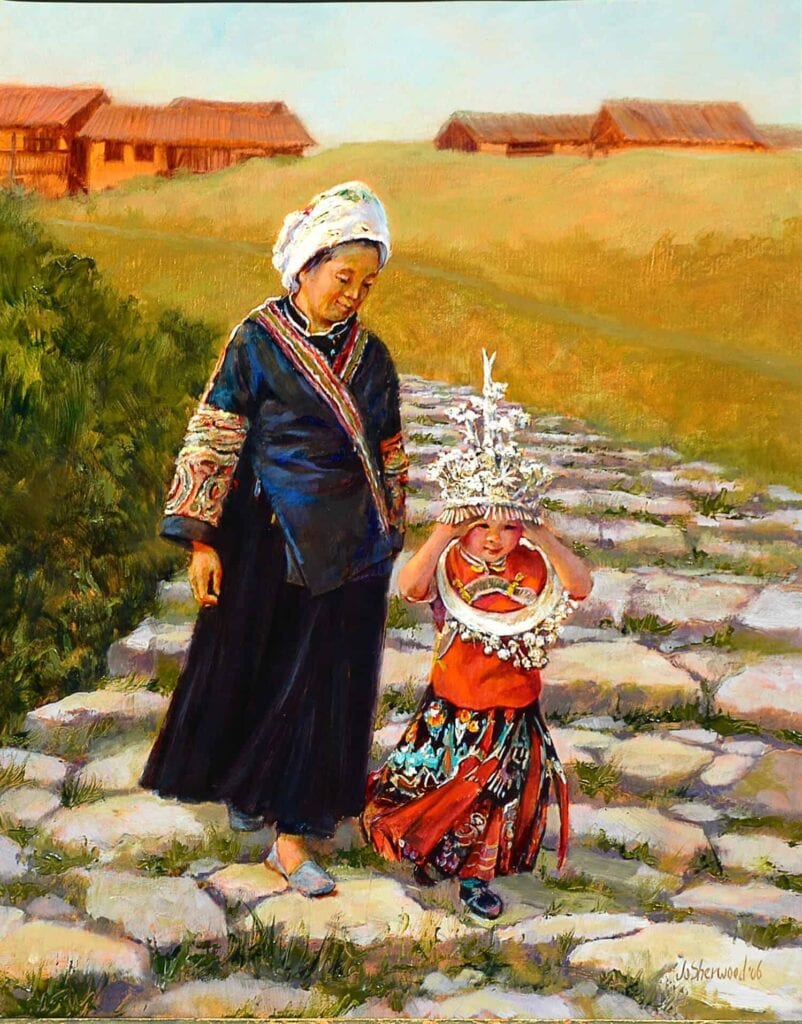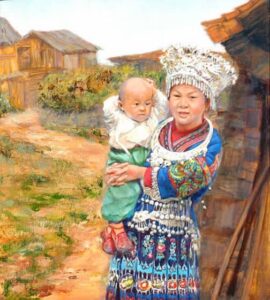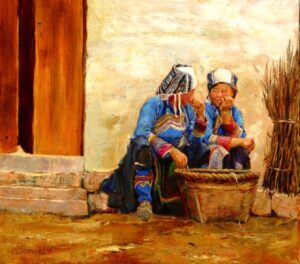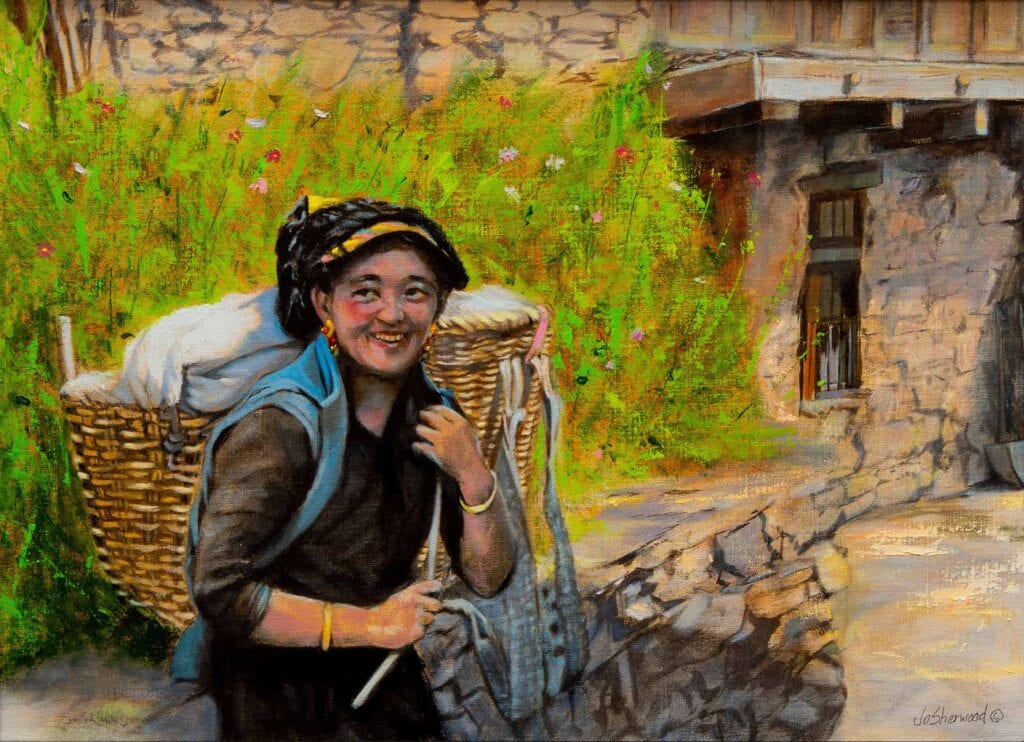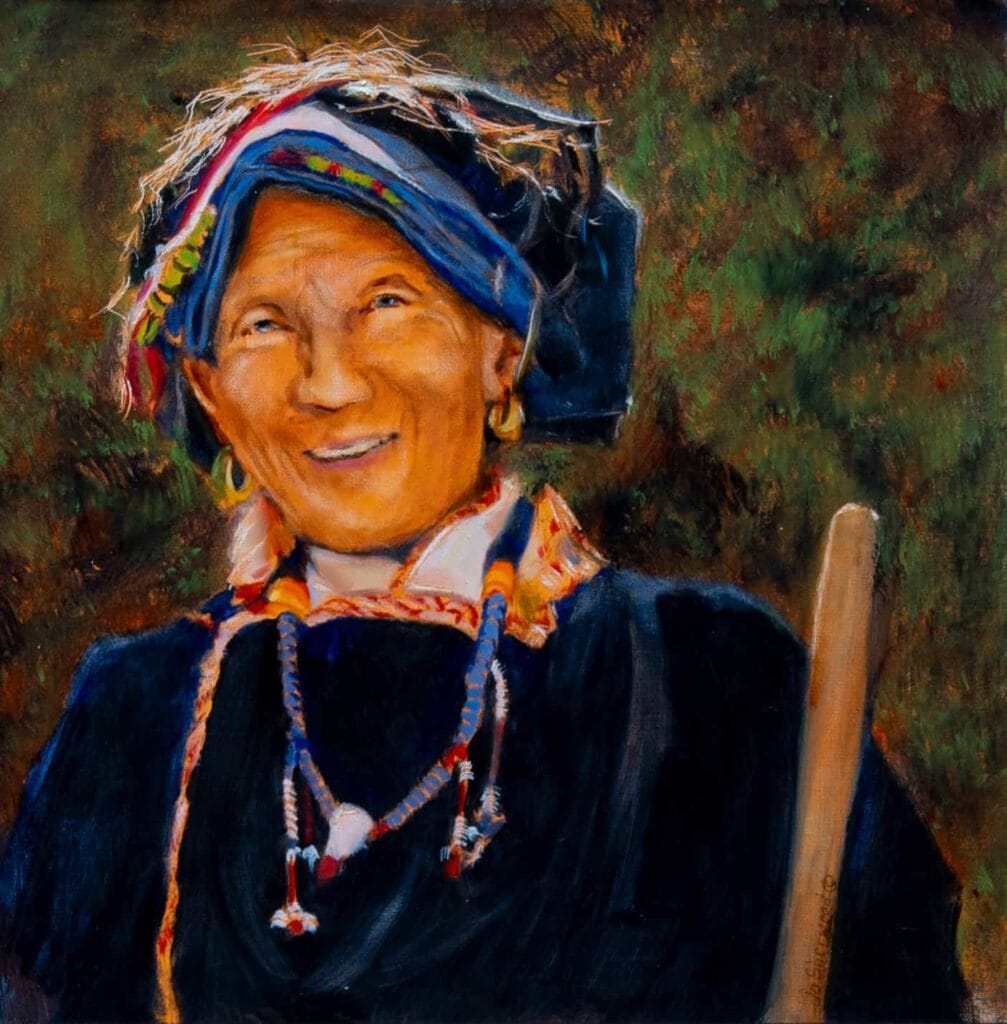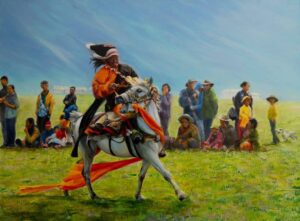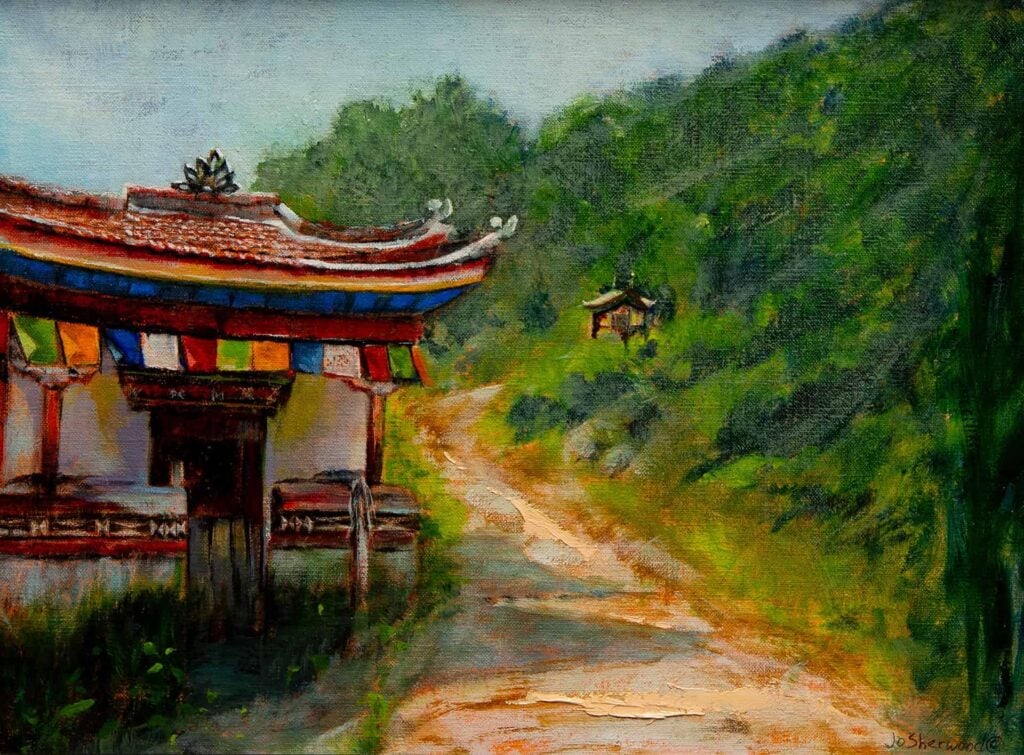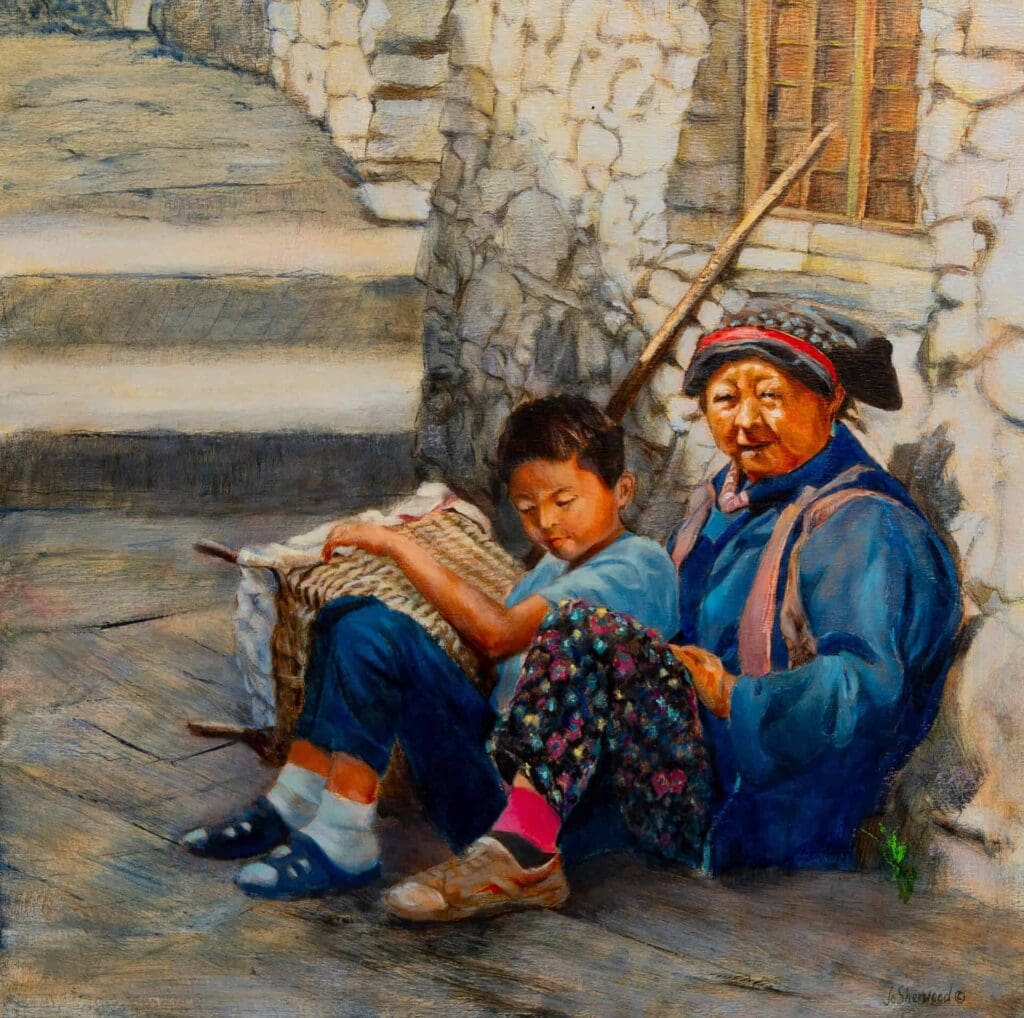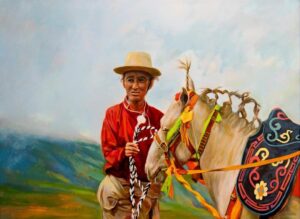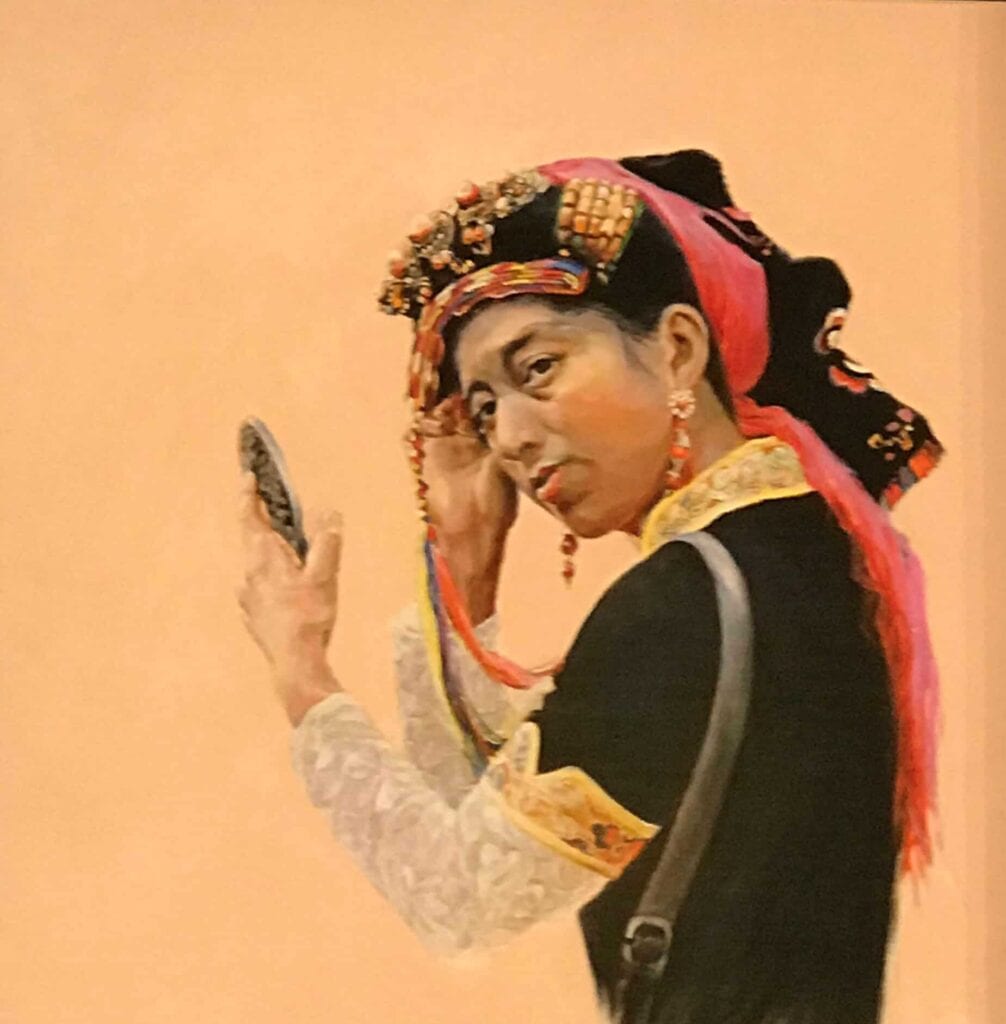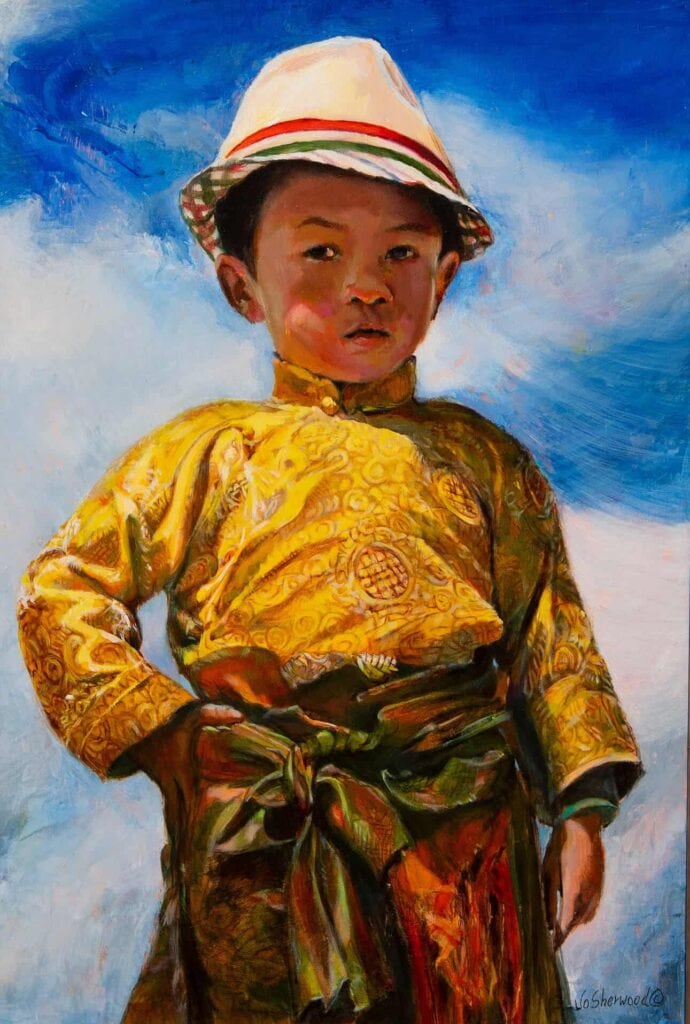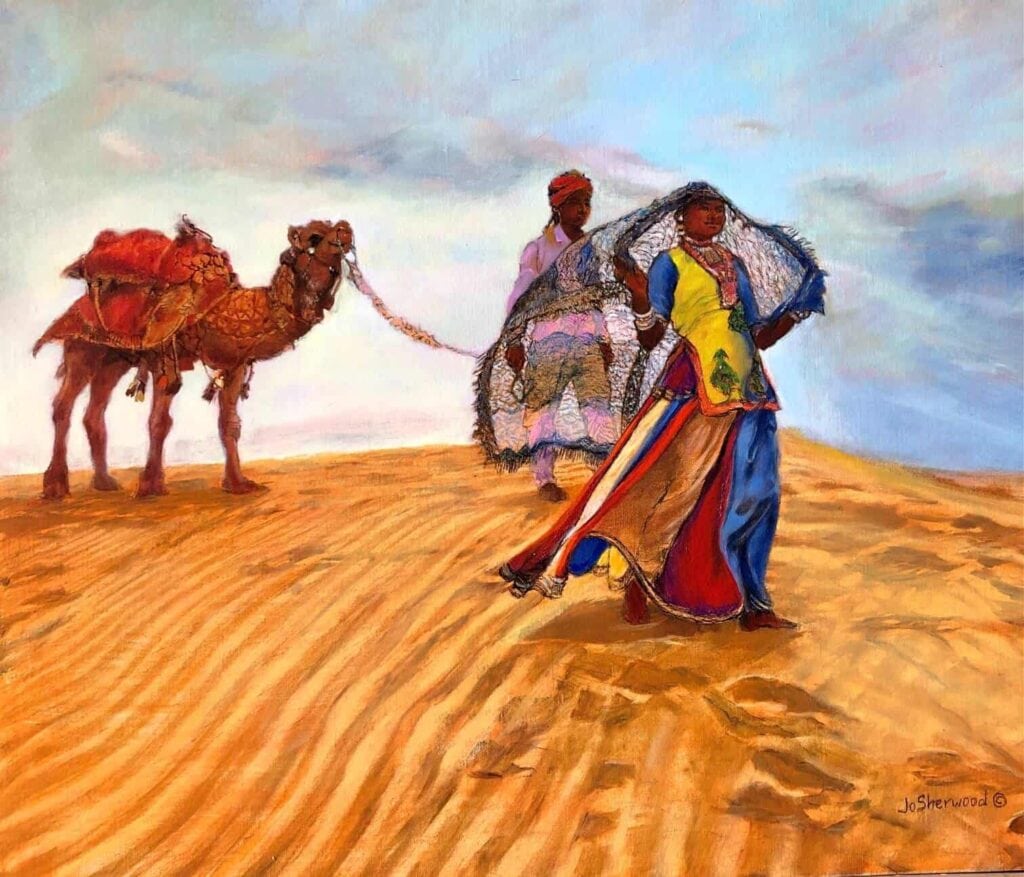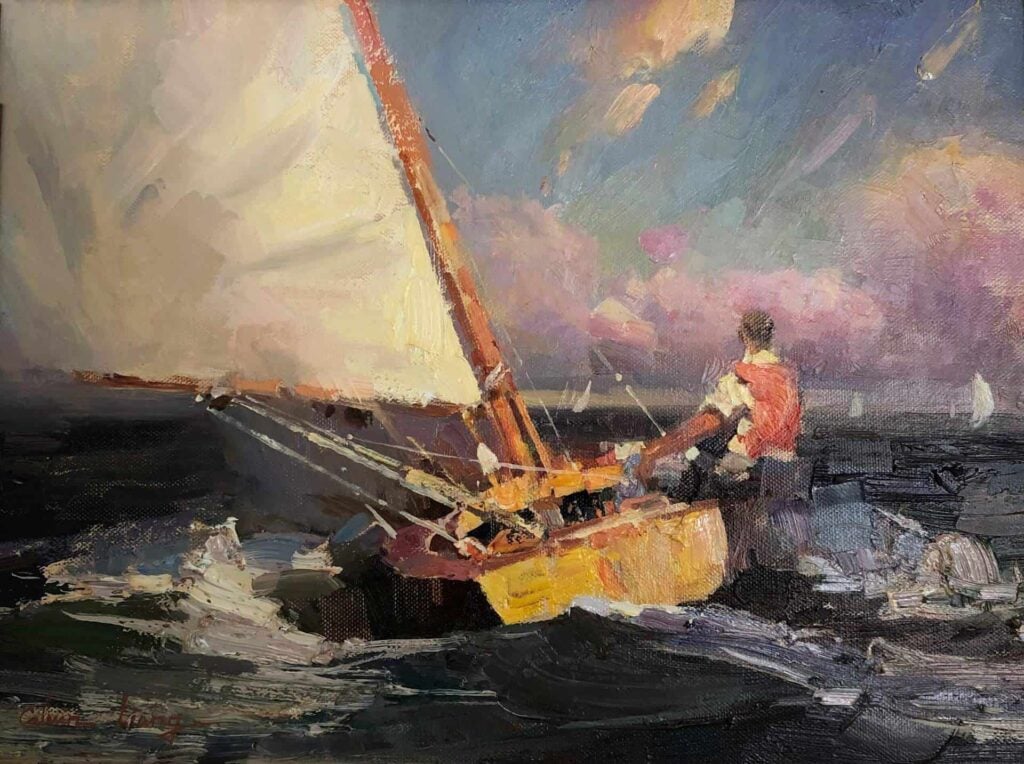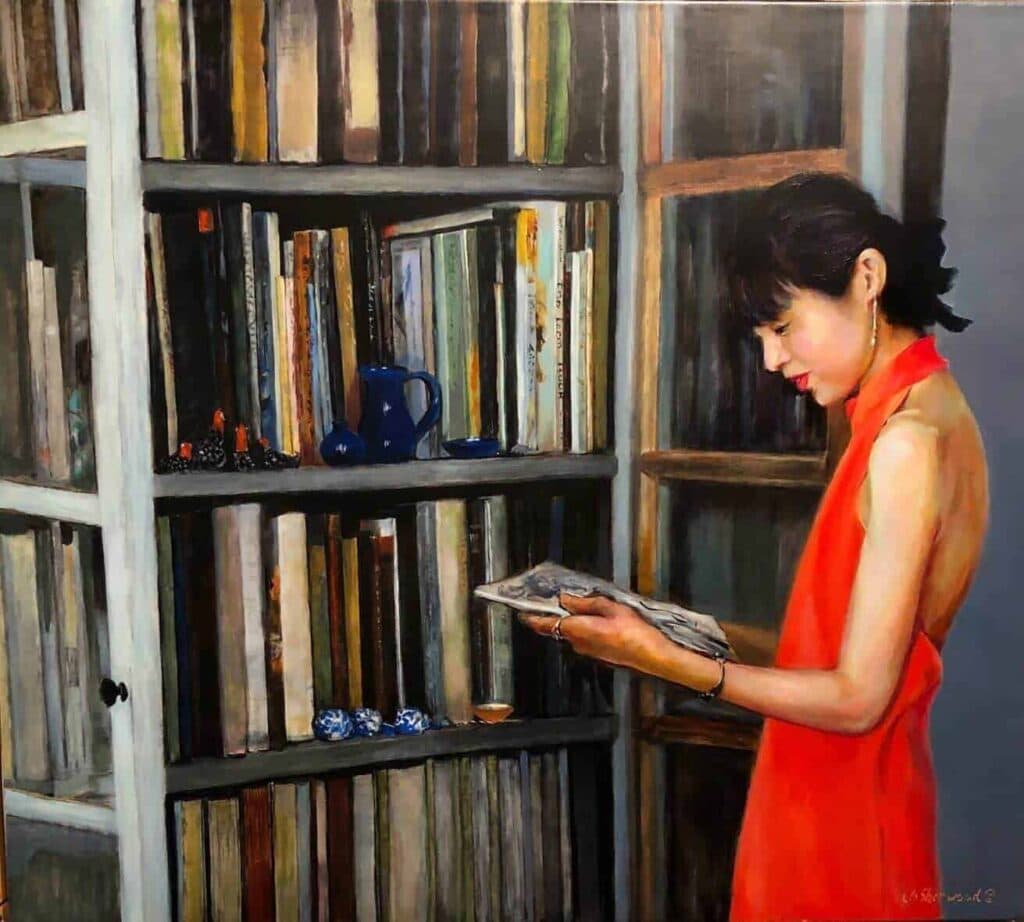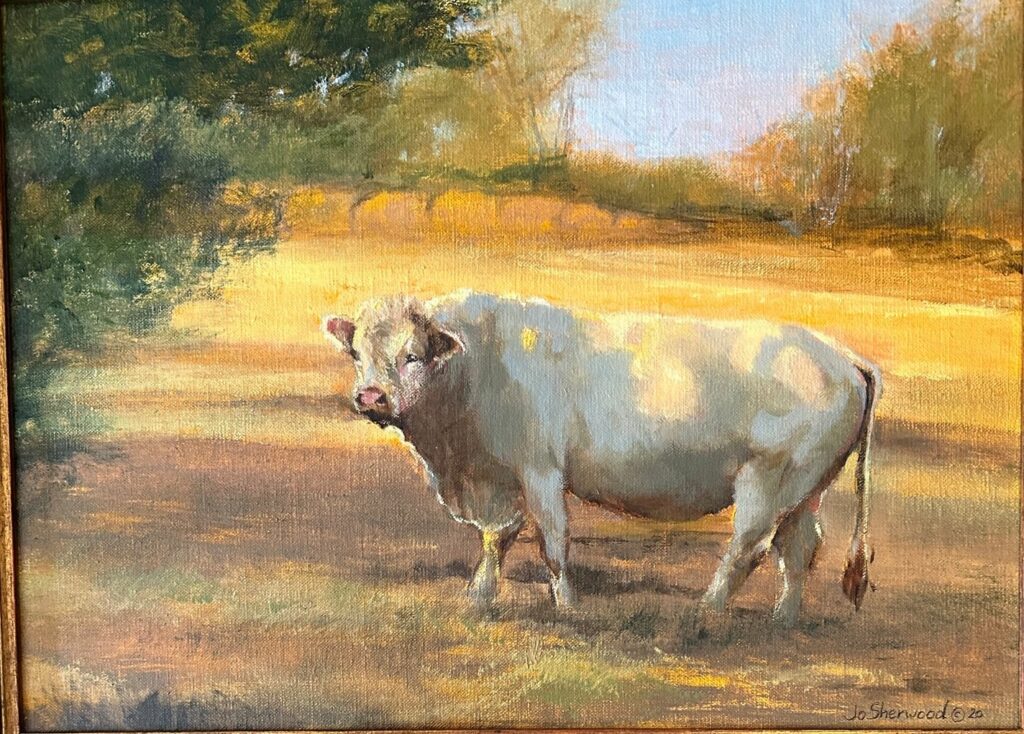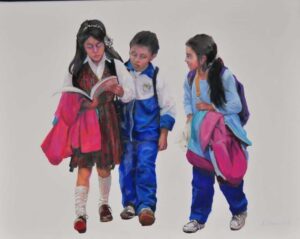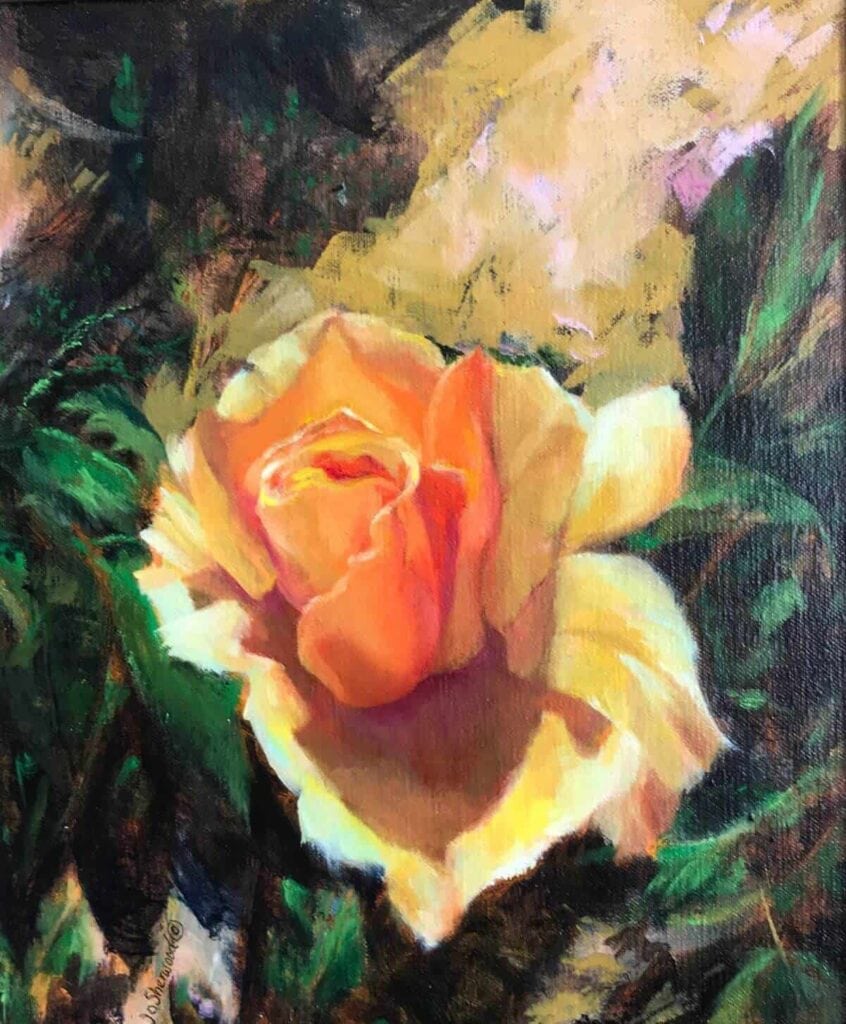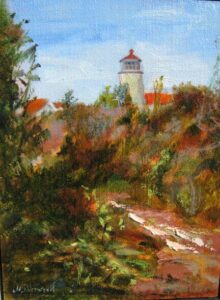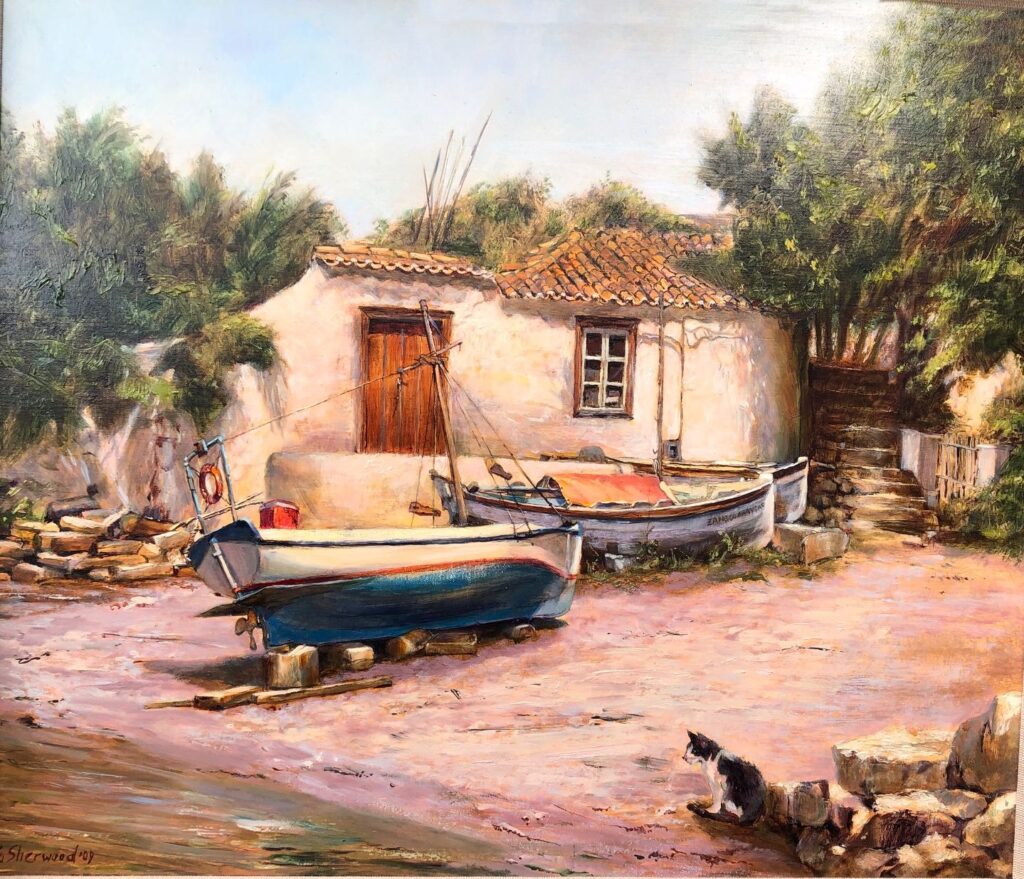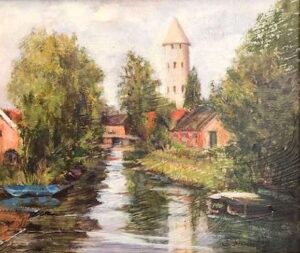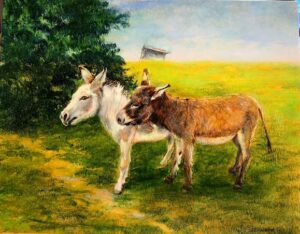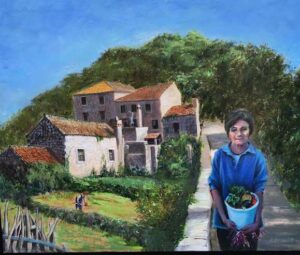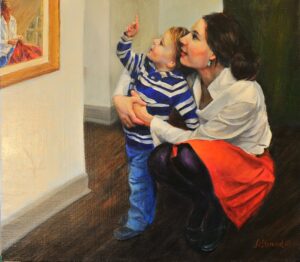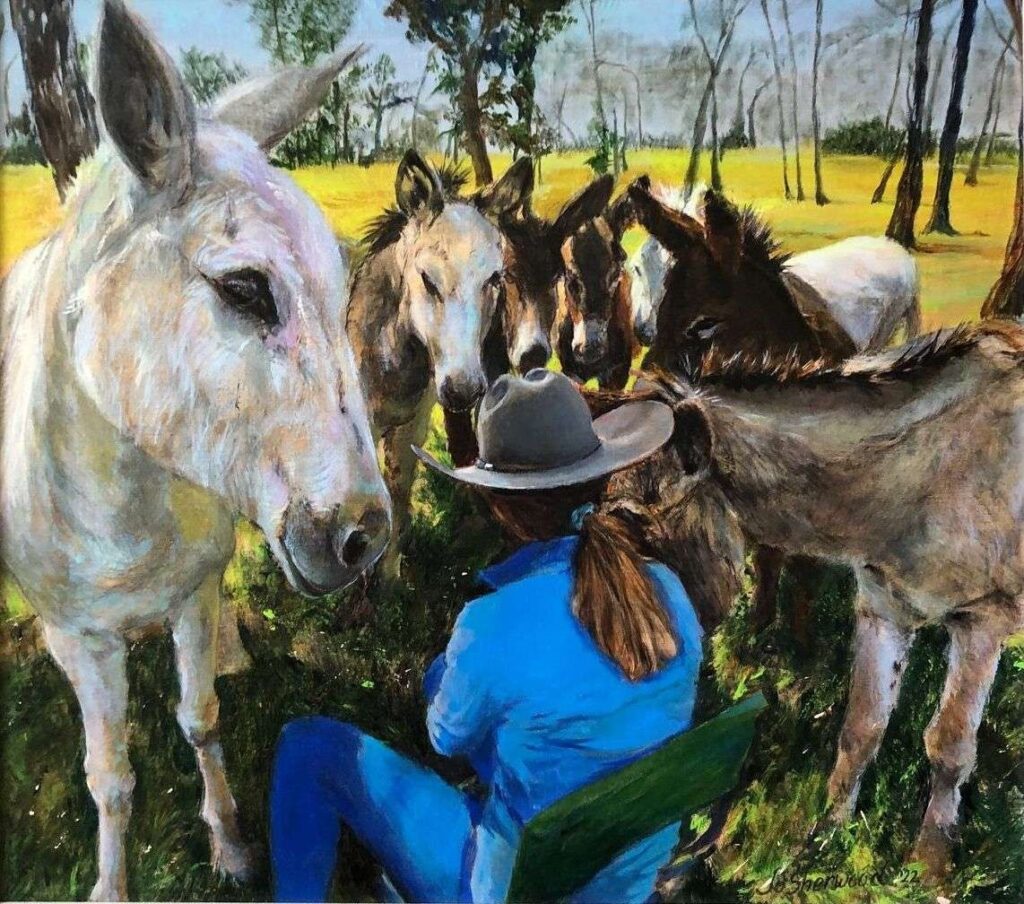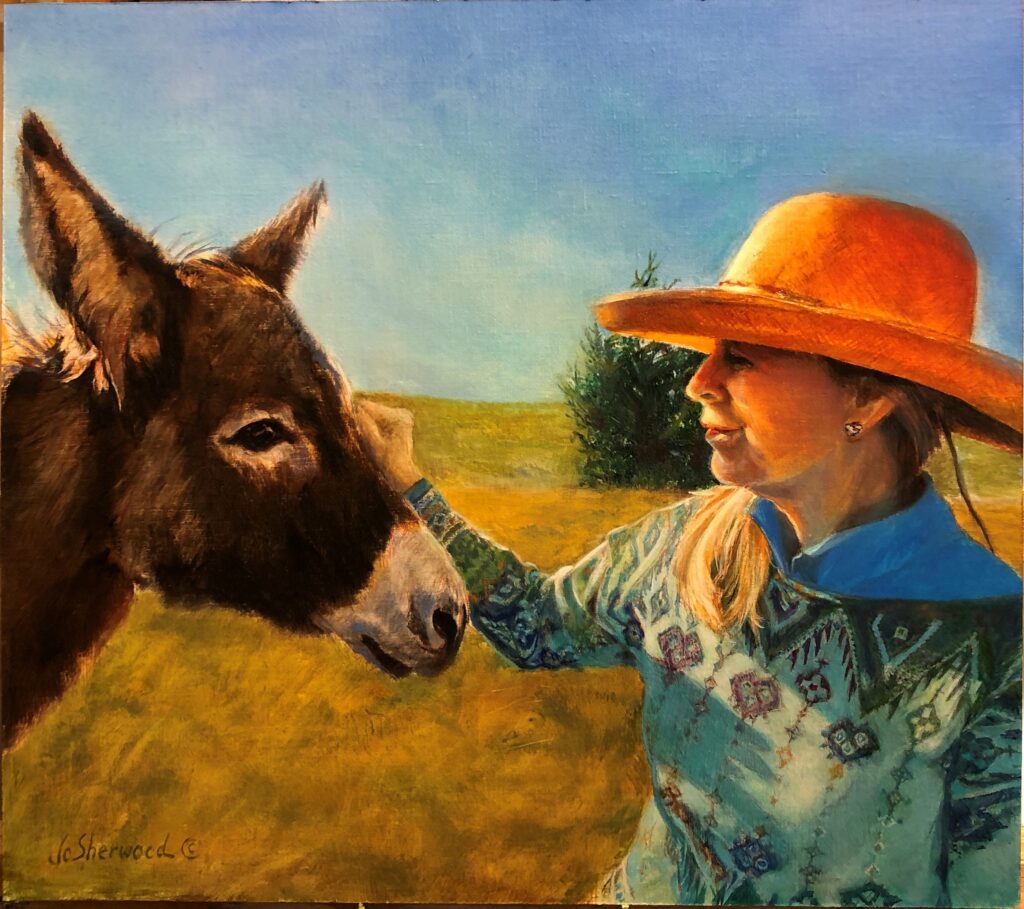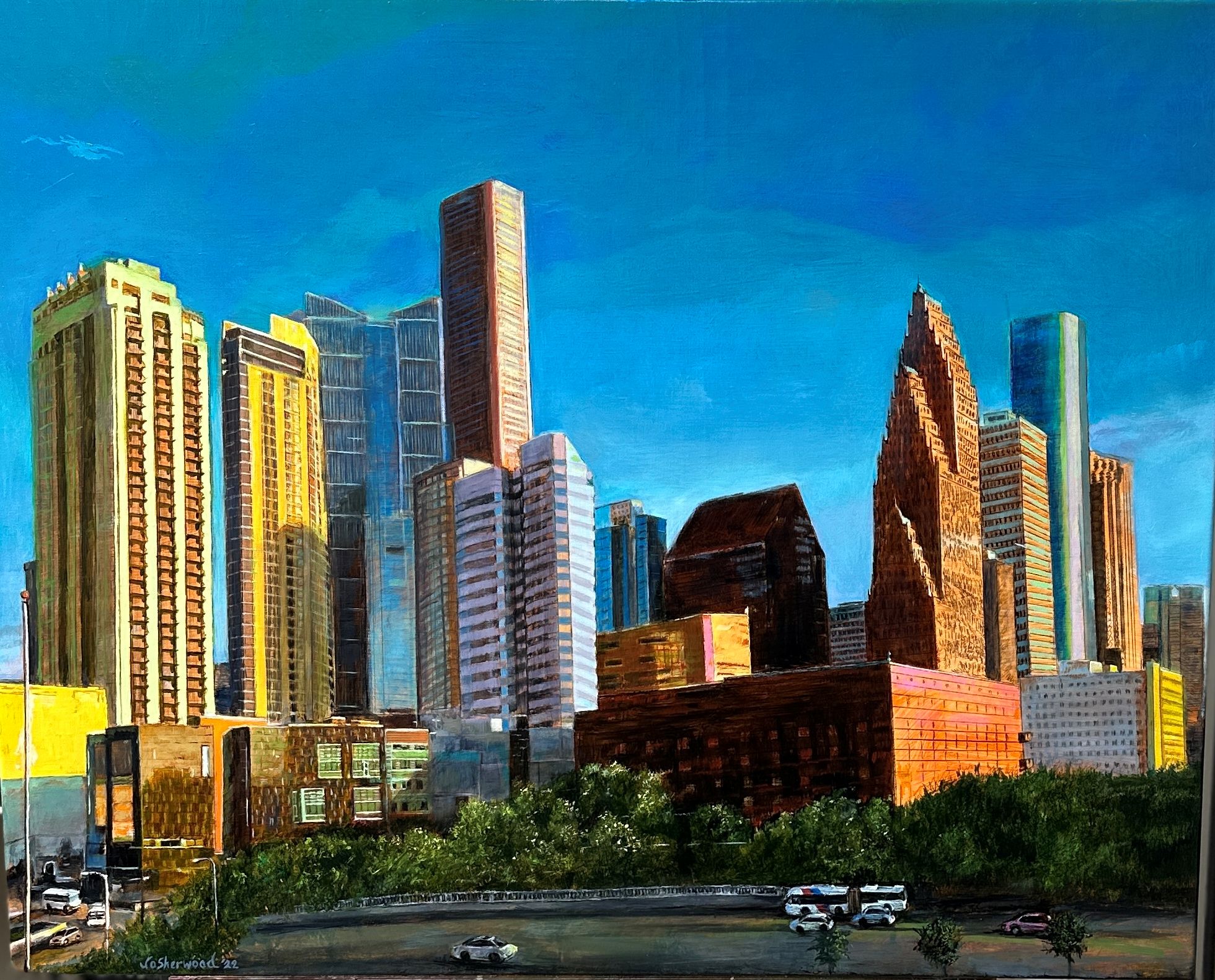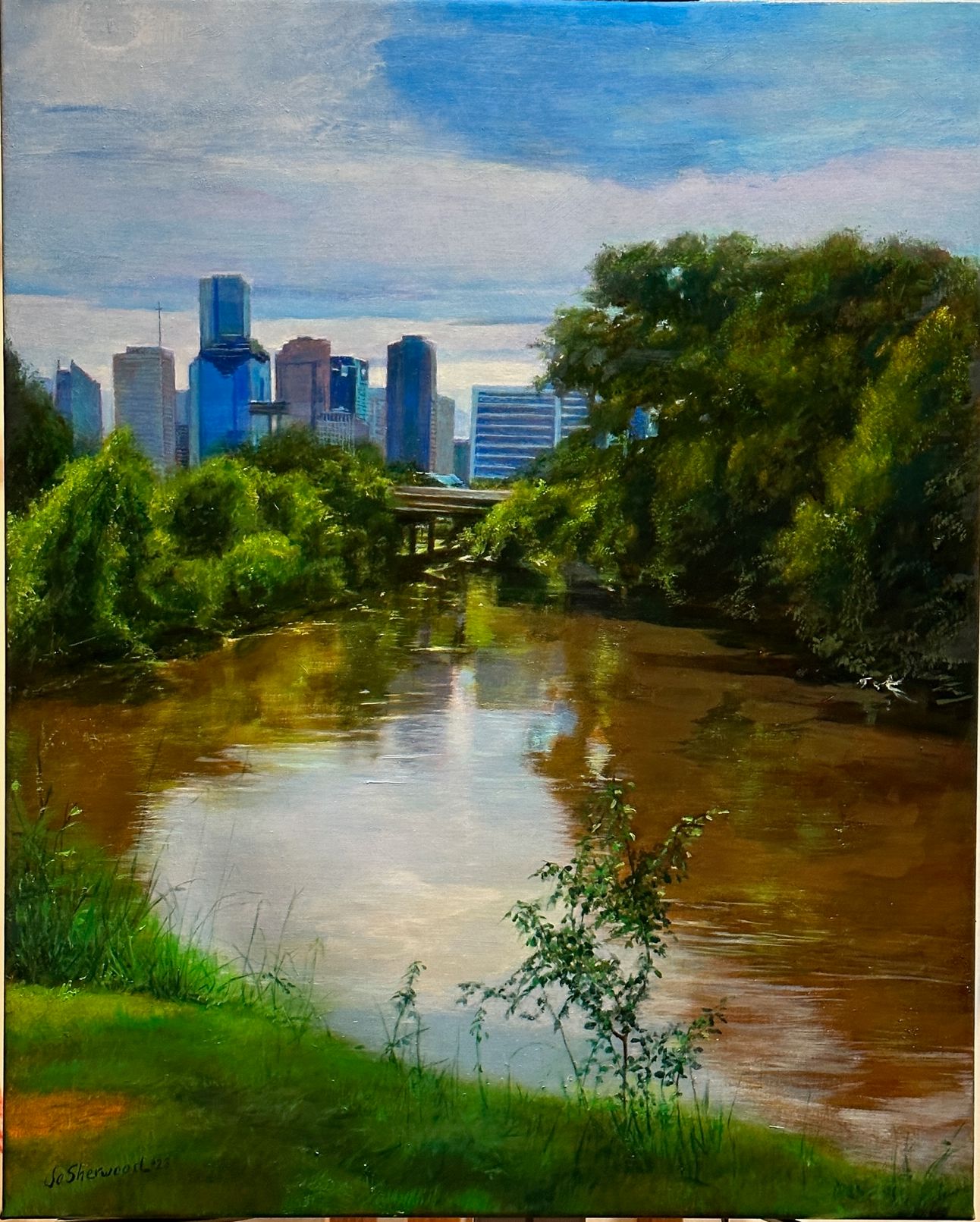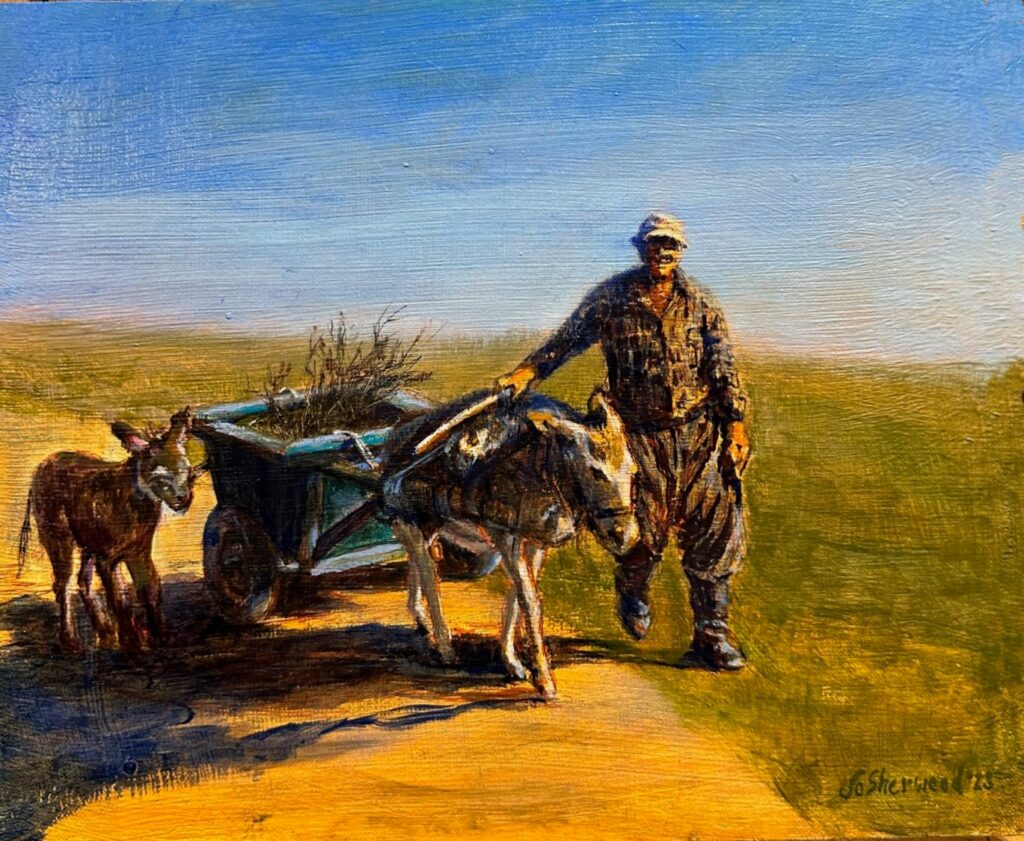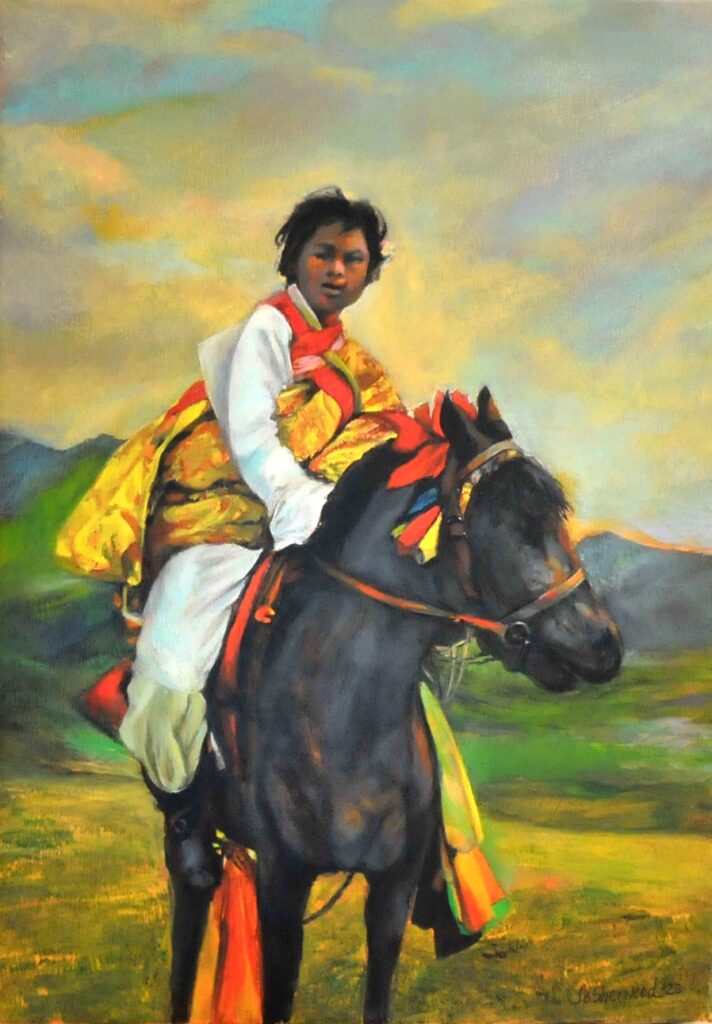Available Paintings
Click for full size photo.
Festival, 19x15” Oil |
In Kali, visiting the Ma Tang Ge Miao in China, a grandmother taking her grandchild to the traditional festivities.
Celebration, 17x15” Oil on Belgium linen
The Miao people show their beautifully, hand embroidered and silver decorated traditional costumes for special celebrated dances.
After the Market, 18x20" Oil
Casual afternoon gossip in traditional dress. Villagers enjoy moments of rest during their daily tasks, including a visit to the village market, where all farmers sell their wares.
Tibetan Wedding, 18" x 22" Oil on Linen
Bride and Groom dressed in formal, elaborate traditional wedding dress. The couple walked behind an announcer with a microphone and amplifier to where the actual ceremony was going to be held.
Tibetan Villager, 16" x 22" Oil on Linen
Taking a much needed rest from her daily delivery, this young woman brightens the day with a smile. She works all day bringing materials to the local church which is being reconstructed in the village of Song-Dong, China.
Matriarch, 12x12" Oil on Linen
Showing her vintage beauty, this matriarch displayed her finery and dignity at the horse festival. Greeted with a smile, her dress and happy disposition reflect this joyous event.
Tibetan Horse Show,26x35" Oil on Linen
Displaying the traditional spectacle of bravery and horsemanship, this horse and rider charge valiantly in the annual horse festival in Litang, China, while spectators stand in awe.
Tibetan Home, 12" x 16" Oil on Linen
Showcasing its traditional architecture and bright decoration, this typical Tibetan home stands proudly next to a nearby shrine.
Tibetan Guardian II, 15" x 24" Oil on Linen
This grandmother watches tenderly over her two great-gradchildren, who play joyfully during the horse race festival.
Tibetan Guardian, 24" x 24" Oil on Linen
The village grandmother enjoys quality time with her grandson, taking time out of her busy day to appreciate her family.
Tibetan Festival, 24" x 32" Oil on Linen
Taking extra care to ornately dress his horse, this village is on display at the annual Horse show and race in Litang, China.
Tibetan Charm, 20" x 20" Oil on Linen
This Tibetan villager showcases the traditional Tibetan dress of Jia-Ju, China. Peering into her mirror, she gives her dress and jewelry a last minute check before the events of the day.
Tibetan Boy, 22" x 15" Oil on Linen
At the horse race festival in Litang, China, this young boy shows the wardrobe of traditional silk dress with a western fedora.
Indian Camel Walk, 16x20” oil on linen
Jaisalmer in the heart of the Thai Desert founded by Rawai Faisal in 1156AD.
This painting shows a camel walk in the Lakhmana dunes.
Sailing by Calvin Lang,12×16” Oil
This painting offered by Jo Sherwood from her own private collection.
Egyptian Traveler
14x11” Oil on linen
Saqqara, hottest place in the desert in Egypt. Middle Kingdom 1700-1800BC. This young boy displays a close friendship with his donkey.
Best Friends, 28x32” Oil on linen
This young lady values her book collection and calls it her best friends!
This painting is available at the Santa Fe Art Collector Gallery, info@santafeartcollector.com- (505)988-5545 or (505)690-7953
Engage-Educate-Enrich, 24x30" Oil on Belgium Linen
In Columbia these young students are sharping their education to be resourceful for a global economy.
Bodegraven, Holland, 11x13" Oil on board
Painted on location in the province of Friesland, The Netherlands
Donkeys of Independence, Texas, 11x14" Oil on linen board
Two donkey friends, living in Independence, Texas.
Lucia's garden, 21x25" Oil on Linen, Available at the Santa Fe Art Collector Gallery, info@santafeartcollector.com (505) 988-5545 or (505) 690-7953
Lucia, from Croatia, showed her beautifully home grown fruits and vegetable from her garden on the left. Her house is at the end of the road. This painting was painted on location.
Art Show, 30x34" Oil on linen Available at the Santa Fe Art Collector Gallery, info@Santafeartcollector.com (505)988-5545 or (505)690-7953 This mother is showing her young son a fine art oil painting with the hope, this will influence his development for appreciation of fine art oil painting.
Best Friends II, 16x18" Oil on Linen
Artist sketching her beloved donkeys at the Texas (Rescue) Miracle Ranch.
Houston Skyline, 24x30" Oil on Linen,
This view of the Houston Skyline came with an afternoon light display from the
old Houston Postoffice building downtown.
Houston Skyline II, 30x24" Oil on Linen,
This view of the Houston Skyline is from a Buffalo Bayou viewpoint, late morning light.
It displays the abundance of greenery along the Bayou which enters into the Gulf
of Mexico.
Uzbekistan Farmer 10X12" Oil on linen
Wonderful meeting while I was traveling in Uzbekistan
to visit this friendly farmer with his 2 donkeys, a disappearing site in a fast developing country.
Young Tibetan Challenger 20x15 ½” Oil on Linen
Experience the captivating allure of nature in this radiant portrait where the vibrant hues and delicate strokes invite you to immerse yourself in a serene world of tranquility and beauty. Imagine the exciting journey of a young horseback rider venturing through this breathtaking scene adding a sense of adventure to the tranquil setting.
Texas Beefmasters + calves, 11x14” Oil on Archival board
The Beefmaster cattle, is a breed of beef cattle that was developed in the early 1930s by Tom Lasater (the breed founder),[1] from a systematic crossing of Hereford cows and Shorthorn cows with Brahman bulls. The exact mixture of the foundation cattle is unknown, but is thought to be about 25% Hereford, 25% Milking Shorthorn and 50% Brahman. It was first recognized by the USDA as a new breed in 1954. The original intention was to produce cattle that could produce economically in the difficult environment of South Texas. The cattle were selected by using the Six Essentials – weight, conformation, milking ability, fertility, hardiness and disposition. While brownish-red is the most common color, the breed has no color standards. Over the past decade, the Beefmaster breed has become very popular among herd managers using the breed in their heterotic programs for hybrid vigor. These cattle are a versatile breed and adapt to many climates.
Texas Shorthorns, 11x14” Oil on Archival board
Shorthorn cattle. The Shorthorn breed of cattle, which we know today, has evolved over the last two centuries, from Teeswater and Durham cattle found originally in the North East of England, an advantage of the Shorthorn cross is that the steers produced have an excellent rate of gain, good feed conversion and increased marbling and tenderness. Overall the Shorthorn is the ideal breed for the production of a choice high quality beef with its suitability for extensive and organic farming systems. Shorthorns are known for their docile temperaments, materialistic cows, reasonable birth weights and fertility. Shorthorns are also known as a dual-purpose breed (beef and milk) and the Brahman x Shorthorn mothers give a lot of milk, raise big calves, and are excellent mothers.
Texas Romagnolo Bull, 11x14” Oil on Archival board
Romagnolo cattle The Romagnola is a breed of cattle from the Emilia-Romagna region of Northern Italy. It belongs to the Podolic group of grey cattle. The Romagnola is ivory to light grey in colour with black pigmented skin including the muzzle, horn tips, hooves and tail switch. They are horned. The Romagnola is a robust animal showing marked evidence of thickness and muscularity the bulls weighing approximately 1250kg and the cows 750kg. The Romagnola is considered the most resistant to the elements and it’s adaptability to difficult environments. The Romagnola cattle are a dual purpose breed of cattle used for meat production and as draught animals.
Texas Longhorn with calf, 11x14” Oil on archival board
Texas Longhorn cattle. The Texas Longhorn derives from cattle brought to the Americas by Spanish conquistadores from the time of the Second Voyage of Christopher Columbus. It is a hybrid breed resulting from a random mixing of Spanish retinto (criollo) stock and English cattle that Anglo-American frontiersmen brought to Texas from southern and midwestern states in the 1820s and 1830s. The Texas Longhorn breed are direct descendants of the first cattle in the New World.
Horn status: horned, large thick horns
Coat: red, white, black, brown.
The majestic Texas Longhorn is an icon of Texas and the Southwest culture. It represents ranching, the American cowboy and the pioneer. Our history and the Texas Longhorn are inseparable.
Texas Long horns, 11x14” Oil on Archival board
The Texas Longhorn became the foundation of the American cattle industry by claiming first rights in the untamed, newly discovered Americas more than 500 years ago. In 1690, the first herd of cattle was driven north from Mexico to land that would eventually become Texas. By the Civil War, millions of Longhorns ranged between the mesquite-dotted sandy banks of the Rio Bravo to the sand beds of the Sabine. Most of the Longhorns were unbranded, survivors of Indian raids, scattered by stampedes and weather, escaped from missions or abandoned after ranch failures.
Texas Long horns II, 11x14” Oil on Archival board
Texas Longhorn cattle. The Texas Longhorn derives from cattle brought to the Americas by Spanish conquistadores from the time of the Second Voyage of Christopher Columbus. It is a hybrid breed resulting from a random mixing of Spanish retinto (criollo) stock and English cattle that Anglo-American frontiersmen brought to Texas from southern and midwestern states in the 1820s and 1830s. The Texas Longhorn breed are direct descendants of the first cattle in the New World.
Horn status: horned, large thick horns
Coat: red, white, black, brown.
The majestic Texas Longhorn is an icon of Texas and the Southwest culture. It represents ranching, the American cowboy and the pioneer. Our history and the Texas Longhorn are inseparable.
The Texas Longhorn became the foundation of the American cattle industry by claiming first rights in the untamed, newly discovered Americas more than 500 years ago. In 1690, the first herd of cattle was driven north from Mexico to land that would eventually become Texas. By the Civil War, millions of Longhorns ranged between the mesquite-dotted sandy banks of the Rio Bravo to the sand beds of the Sabine. Most of the Longhorns were unbranded, survivors of Indian raids, scattered by stampedes and weather, escaped from missions or abandoned after ranch failures.
Texas Herefords, 11x14” Oil on Archival board
The Hereford is a British breed of beef cattle originally from Herefordshire in the West Midlands of England. It has spread to many countries – there are more than five million purebred Hereford cattle in over fifty nations worldwide. The breed was first exported from Britain in 1817, initially to Kentucky. Beginning in 1742 with a bull calf from the cow Silver and two cows, Pidgeon and Mottle, inherited from his father's estate, Benjamin Tomkins is credited with founding the Hereford breed.
Texas Charolaise,12x16” Oil on linen
The Charolaise is a French breed of taurine beef cattle. It originates in, and is named for the Charolais area surrounding Charolles, in the Saône-et-Loire department, in the Bourgogne-Franche-Comté region of eastern France.
Characteristics. The typical Charolaise is white in color with a pink muzzle and pale hooves, horned, long bodied, and good milkers with a general coarseness to the animal not being uncommon. There are now Charolaise cattle being bred black and red in color.
AVAILABILITY for purchase, at art@sherwoodsgallery.com - 713 974-3700
Texas Brindles, 11x14” Oil on Archival board
The Brindle cattle is an interesting combination of black and brown, or brown with red or yellow. We were very surprised when this showed up in our herd in a calf by a reddish brown Beefmaster bull out of an Angus/Hereford cross cow.
“Tigerstripe” is a term used to describe the F1 cross of Hereford and Brahman because of the animal's tiger-like striped brindle hair. The cross is traditionally known to combine the beefier Hereford of English descent with the more heat-tolerant Bos indicus Brahman.
Texas Brindle Cow, 11x14” Oil on Archival board
The Brindle cattle is an interesting combination of black and brown, or brown with red or yellow. We were very surprised when this showed up in our herd in a calf by a reddish brown Beefmaster bull out of an Angus/Hereford cross cow.
“Tigerstripe” is a term used to describe the F1 cross of Hereford and Brahman because of the animal's tiger-like striped brindle hair. The cross is traditionally known to combine the beefier Hereford of English descent with the more heat-tolerant Bos indicus Brahman.
Texas Brahman Cow, 11x14” Oil on Archival board
The Brahman cattle, is an American breed of zebuine-taurine hybrid beef cattle. It was bred in the United States from 1885 from cattle originating in India.
Brahmans are intelligent, inquisitive and shy. They are unusually thrifty, hardy and adaptable to a wide range of feed and climate. However, these characteristics also suggest careful, kind handling methods. Brahmans like affection and can become very docile.
Like the camel, the Brahman stores food and water in the odd- looking hump on its back. The hump is a deposit of fat. Farmers and ranchers in the southeastern US and the Gulf States like to raise Brahman cattle because they can stand the heat, and insects don't bother them much.
Texas Brahman Bull, 11x14” Oil on Archival board
The Brahman cattle, is an American breed of zebuine-taurine hybrid beef cattle. It was bred in the United States from 1885 from cattle originating in India.
Brahmans are intelligent, inquisitive and shy. They are unusually thrifty, hardy and adaptable to a wide range of feed and climate. However, these characteristics also suggest careful, kind handling methods. Brahmans like affection and can become very docile.
Like the camel, the Brahman stores food and water in the odd- looking hump on its back. The hump is a deposit of fat. Farmers and ranchers in the southeastern US and the Gulf States like to raise Brahman cattle because they can stand the heat, and insects don't bother them much.

